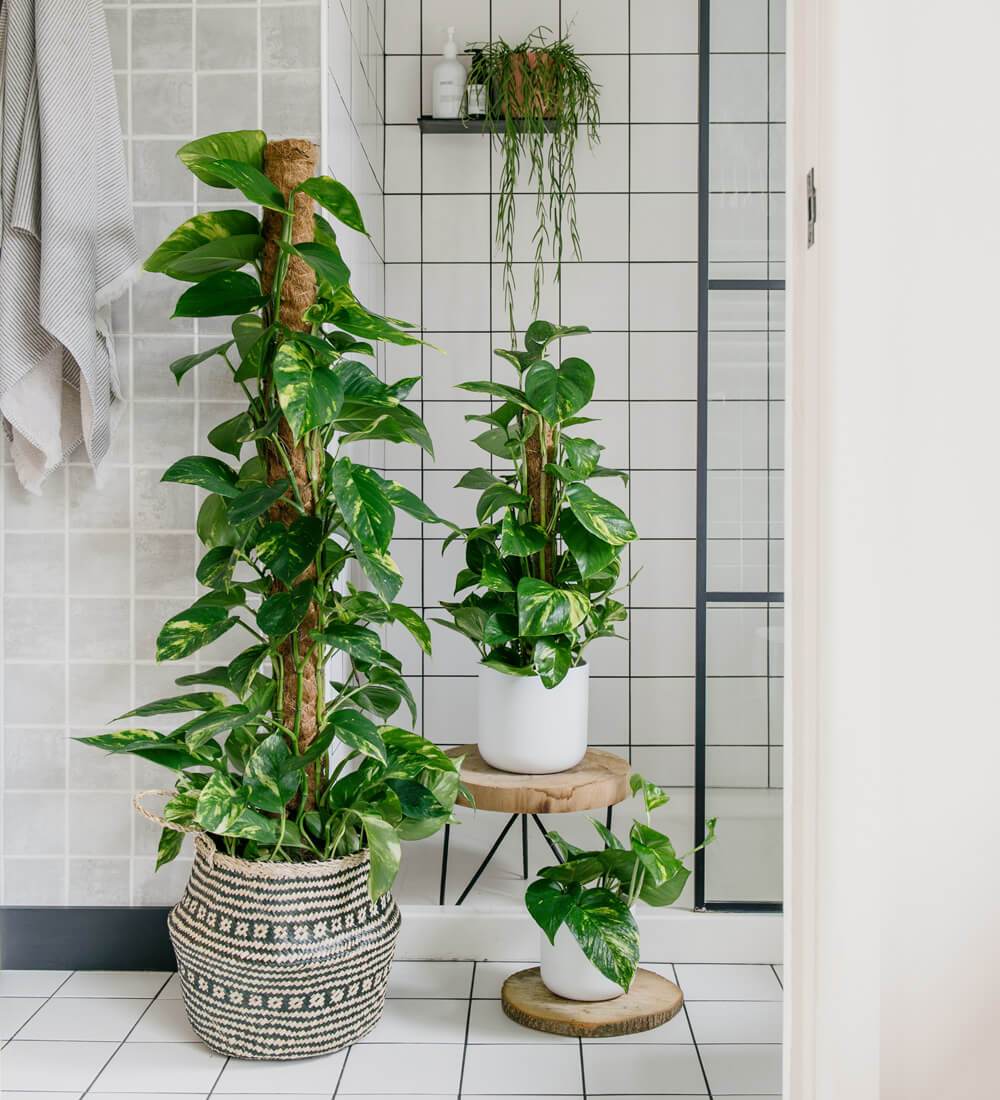
Epipremnum aureum. Copyright: Beard & Daisies.
Contents
- Top Tips
- Location, Water, Humidity & Fertilisation
- Common Issues
- Origins, Temperature, Propagation, Repotting & Toxicity.
Need the answer to a specific plant query? Book a 1-to-1 video call with THE HOUSEPLANT DOCTOR™, the website's friendly author, to overcome and address your niggling problem! Available on iMessage, WhatsApp, Facebook Messenger & more.
Top Tips & Info
- Care Difficulty - Very Easy
- Provide a bright, indirect location with the absence of direct sun.
- Allow the soil's top third to dry out in between waters, reducing this in the autumn and winter.
- Fertilise using a 'Houseplant' labelled feed every four waters in the spring and summer, reducing this to every six in the colder months.
- Keep an eye out for Spider Mites that'll form webs on the under-leaves of the plant.
- Repot every three years using a 'Houseplant' soil and the next sized pot. Scroll down to the 'Repotting' section to learn more about repotting a specimen that's attached to a moss pole.
- Keep an eye out for any loss of pre-existing variegations (patterns), as too-dark locations will cause them to fade & disappear. Settings that are too bright may develop exaggerated variegations with little to no green tissue.
- Why not buy our top-selling Pothos Soil Mix here? We have sold over 1,600 batches in the last year alone, so click here to find out more...
Location & Light - 🔸🔸
Provide a bright, indirect location with minimal sunlight. Those grown in a darker setting will significantly increase the chance of root rot, as well as variegated specimens losing their colourful patterns.
Remember - The amount of light and current season of the year will directly govern the frequencies of waters per month. Specimens placed in shadier areas must be kept on the drier side to life, whereas brighter locations will require more soil moisture to lubricate photosynthesis.
Water - 🔸🔸
Allow the top third of the soil to dry out in between waters, reducing this further in the autumn and winter. For those situated in shadier environments, allow around half of the soil dry out in between waters to counteract the chance of over-watering, especially in the winter months. Under-watering symptoms include stunted growth, yellowing leaves or sudden flower loss. These issues could be a product of many elements; however, too much sunlight or forgetfulness are usually the culprits. Over-watering symptoms include the yellowing or loss of leaves, stunted growth or a rotten base. These problems are typically familiar with either too little light or heat or overly soggy soil; if you feel that root rot is the case, be sure to click on this link for more info.
Humidity - 🔸🔸
Average room humidity is excellent for Devil's Ivy, as over-misting may cause the development of powdery mildew or botrytis. At monthly intervals, perform a gentle hose-down to hydrate its leaves and reduce the number of dust particles resting on its foliage.
Fertilisation - 🔸🔸
Fertilise every four waters during the growing period before reducing this to every six in the autumn & winter. Although an 'All-Purpose' fertiliser will still do the job, we'd recommend using a specific 'Houseplant' labelled fertiliser as it'll support the vital thirteen nutrients that this species will need to grow.
Common Issues with Devil's Ivy (Pothos, Epipremnum & Scindapsus)
A loss of variegations is caused by too little light. Although Devil's Ivy is an excellent choice for shady locations, it'll come at the cost of its variegations. Move the plant into a brighter area with minimal direct sunlight to allow the variegations to appear on the new growth. If you aren't entirely displeased about the loss, simply skip this step. Alternatively, extreme variegations that hinder the plant from developing chlorophyll (green pigmentation) is typically caused by too much sunlight.
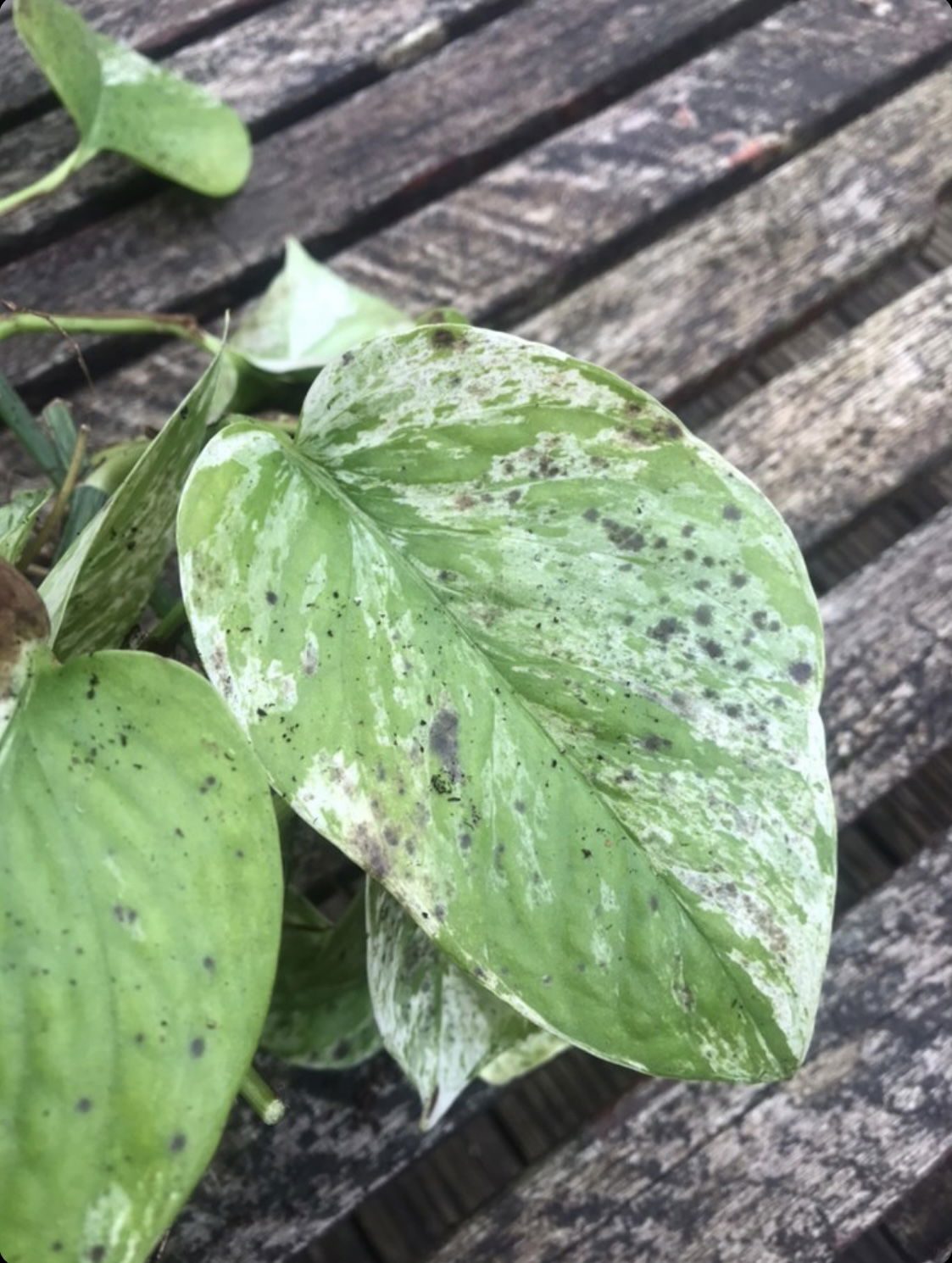 Disease can sometimes take control of your Devil's Ivy. We recommend pruning the affected areas and increase fertilisation to build the plant's strength. Ensure your plant receives enough light and wait for improved, unaffected new growth in weeks to follow.
Disease can sometimes take control of your Devil's Ivy. We recommend pruning the affected areas and increase fertilisation to build the plant's strength. Ensure your plant receives enough light and wait for improved, unaffected new growth in weeks to follow.
Is your Devil's Ivy producing smaller leaves or just naked, leggy stems each time it grows? It's most likely to do with its light levels or low temperatures. We recommend improving its location by placing it in a sunless windowsill or under a grow light for better, more reliable growth. You can also consider pruning any leggy, leafless stems back to the first leaf to promote a new cluster of foliage in months to come. Other reasons for its reduction of leaf size could be: an absence of a moss pole or plant to climb up, a lack of fertilisation and/or root rot.
Root rot is a common issue with specimens sat in too moist or waterlogged soil for long periods. Symptoms include rapidly yellowing leaves, stunted growth and a rotten brown base. Take the plant out of the pot and inspect health below the soil line. If the roots sport a yellow tinge, you're good to go, but if they're brown and mushy, action must be taken immediately. More information about addressing root rot can be found on this link.
 If your Devil's Ivy has lost leaves in a certain area of its stem (or is growing long stems with no leaves), this is to do with too little light. Consider pruning the stem(s) back to promote a bushier appearance and propagate the cuttings in water. Transplant them into the original plant's soil once the roots are 5cm (2 inches to further thicken the overall foliage. (Although the plant is a Monstera adansonii, the principle is identical).
If your Devil's Ivy has lost leaves in a certain area of its stem (or is growing long stems with no leaves), this is to do with too little light. Consider pruning the stem(s) back to promote a bushier appearance and propagate the cuttings in water. Transplant them into the original plant's soil once the roots are 5cm (2 inches to further thicken the overall foliage. (Although the plant is a Monstera adansonii, the principle is identical).
Pests could arise at any time, with infestations starting from the original nursery or via contamination in your home. With Devil's Ivy, Spider Mites and Mealybugs tend to be the usual inhabitants, with the first being minute and almost transparent, roaming the leaves in search of chlorophyll and a site to hide its eggs. The latter, however, will stand out much more, with white cottony webs developing across the foliage and stems. Thoroughly check the plant's cubbyholes before giving it the all-clear, or click on the appropriate links to learn more about eradicating these issues.
Always use lukewarm water, and if you choose to use tap water, allow it to stand for at least 24hrs before application. Devil's Ivy tend to be quite sensitive to temperature change, so pouring cold tap water immediately into the pot will not only add fluoride into the soil, but it could even lead to yellowed leaves over time!
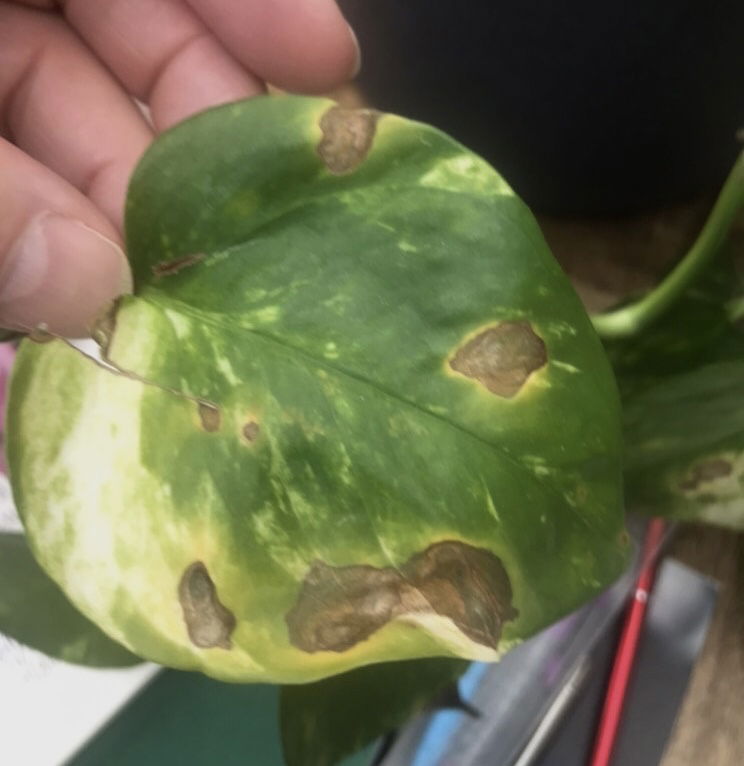 This issue was caused by using too cold tap water, along with a lack of fertilisation. It's best to use tap water that's allowed to sit for 24hrs, which will help settle the temperature and contained chemicals for hygiene. Prune off the most affected areas and fertilise with a 'Houseplant' labelled feed to help the new juvenile growth from adopting these issues.
This issue was caused by using too cold tap water, along with a lack of fertilisation. It's best to use tap water that's allowed to sit for 24hrs, which will help settle the temperature and contained chemicals for hygiene. Prune off the most affected areas and fertilise with a 'Houseplant' labelled feed to help the new juvenile growth from adopting these issues.
Curled leaves and brown leaf-edges are the result of too little water and over-exposure to the sun. Devil's Ivy are best located in bright, indirect settings, and those that haven't acclimatised to the harsh rays will show signs of sun-scorch and environmental shock. A splash of winter sunlight is acceptable as long as the soil moisture is regularly observed, with complete avoidance once summer comes along.
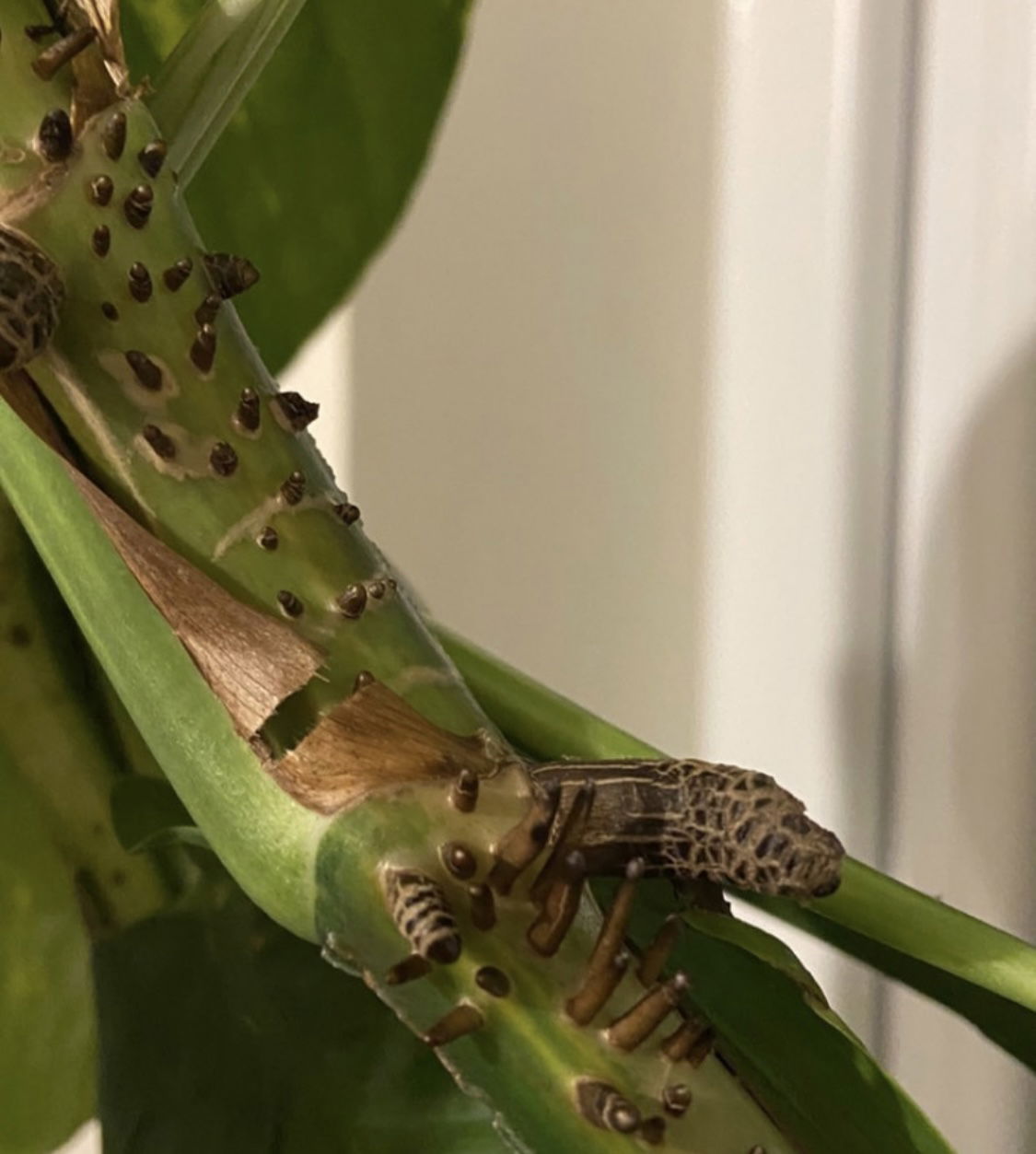 Short brown bumps on your plant's vines are dormant root nodes that'll spring into life when exposed to moisture. In the wild, these root nodes will emerge and stick onto the nearest tree or structure, allowing the plant to reach the tree's canopy in record time.
Short brown bumps on your plant's vines are dormant root nodes that'll spring into life when exposed to moisture. In the wild, these root nodes will emerge and stick onto the nearest tree or structure, allowing the plant to reach the tree's canopy in record time.
Too low humidity can cause browning leaf tips with yellow halos. Although this won't kill your specimen, you may want to increase the local moisture to prevent the new growth from adopting these symptoms. Mist or rinse the foliage from time to time and create a humidity tray whilst the heaters are active to create a stable environment for your specimen.
 Irregular watering of both under, and then over-watering, could be to blame for this issue. Try introducing a 'watering-rota' to avoid sudden droughts which may result in weakened growth.
Irregular watering of both under, and then over-watering, could be to blame for this issue. Try introducing a 'watering-rota' to avoid sudden droughts which may result in weakened growth.
The browning of each cataphyll shouldn't of be a concern, as it's a wholly natural process which affects all specimens across the world. Remove the brown section once it becomes dry and crispy, using your hands to peel back the browned tissue and improve its overall appearance.
Yellowing lower leaves (closest to soil) are a clear sign of over-watering, usually caused by too little light. Although they can do well in darker locations, the frequency of irrigations must be reduced to counteract the chance of root rot. People don't realise that a plant's root system needs access to oxygen too; when soil is watered, the air will travel upwards and out of the potting mix. A lack of accessible oxygen for the roots will cause them to subsequently breakdown over the oncoming days. Click on this link to learn more about root rot and how to address it, and always feel the pot's weight for confirmation (heaviness = good soil moisture, & vice versa).
Origins
Devil's Ivy forms part of the Arecaceæ family that hold genera such as Spathiphyllum (Peace Lilies), Alocasia and Zamioculcas (ZZ plants). It has had multiple names since being formally classified in 1880, including Pothos, Rhaphidophora aurea, and finally into the genus of Epipremnum. The species is reluctant to bloom, with the last known natural flower being recorded in 1962, the same year in which its name transitioned from Pothos to Rhapidophora. Despite its name change, the new placement in this genus didn't last long; additional inspection of its flowers strongly indicated the similarities between another genus, Epipremnum, and was subsequently replaced a short while after.
The nickname, Devil's Ivy, refers its ability to remain green even in intensively dark locations, as well as its hard-to-kill ethics. 'Scindapsus' was mainly used in 1908 and derived from the Ancient Greek instrument, skindapsos - a four-stringed instrument struck by fingers. The two most popular variants of the genus, the E. pictum & E. aurea, originate from the Society Islands and can be translated from Greek as 'to paint' and from Latin meaning 'gold or golden', respectively.
 The Distribution of Devil's Ivy.
The Distribution of Devil's Ivy.
Temperature
12° - 30°C (54° - 86°F)
H1b (Hardiness Zone 12) - Can be grown outdoors during the summer in a sheltered location with temperatures above 12℃ (54℉), but is fine to remain indoors, too. If you decide to bring this plant outdoors, don't allow it to endure more than an hour of direct sunlight a day as it may result in sun-scorch. Regularly keep an eye out for pests, especially when re-introducing it back indoors.
Spread
Up to 8m in height and 3m in width, when given a structure to climb up; the ultimate height will take between 5 - 8 years to achieve. Devil's Ivy that naturally grow in the wild can reach heights of up to twenty metres; however, smaller root systems and less favourable growing conditions will significantly reduce the overall height.
 Allowing Devil's Ivy to climb up walls or moss poles is an excellent way to promote longer vines. These sticky-pad clips can be found at local hardware stores for relatively cheap prices!
Allowing Devil's Ivy to climb up walls or moss poles is an excellent way to promote longer vines. These sticky-pad clips can be found at local hardware stores for relatively cheap prices!
Pruning & Maintenance
Remove yellow or dying leaves, and plant debris to encourage better-growing conditions. While pruning, always use clean scissors or shears to reduce the chance of bacterial and fungal diseases. Never cut through yellowed tissue as this may cause further damage in the likes of diseases or bacterial infections. Remember to make clean incisions as too-damaged wounds may shock the plant, causing weakened growth and a decline in health.
Although the aerial roots aren't exactly appealing, do not remove them as it may put stress upon the plant and potentially could weaken it with potential diseases.
 Although it'll look messy at first, the vines will slowly branch out to the majority of the wall. Plant: Scindapsus pictus 'Argyraeus'
Although it'll look messy at first, the vines will slowly branch out to the majority of the wall. Plant: Scindapsus pictus 'Argyraeus'
Propagation
Via Seed or Stem Cuttings.
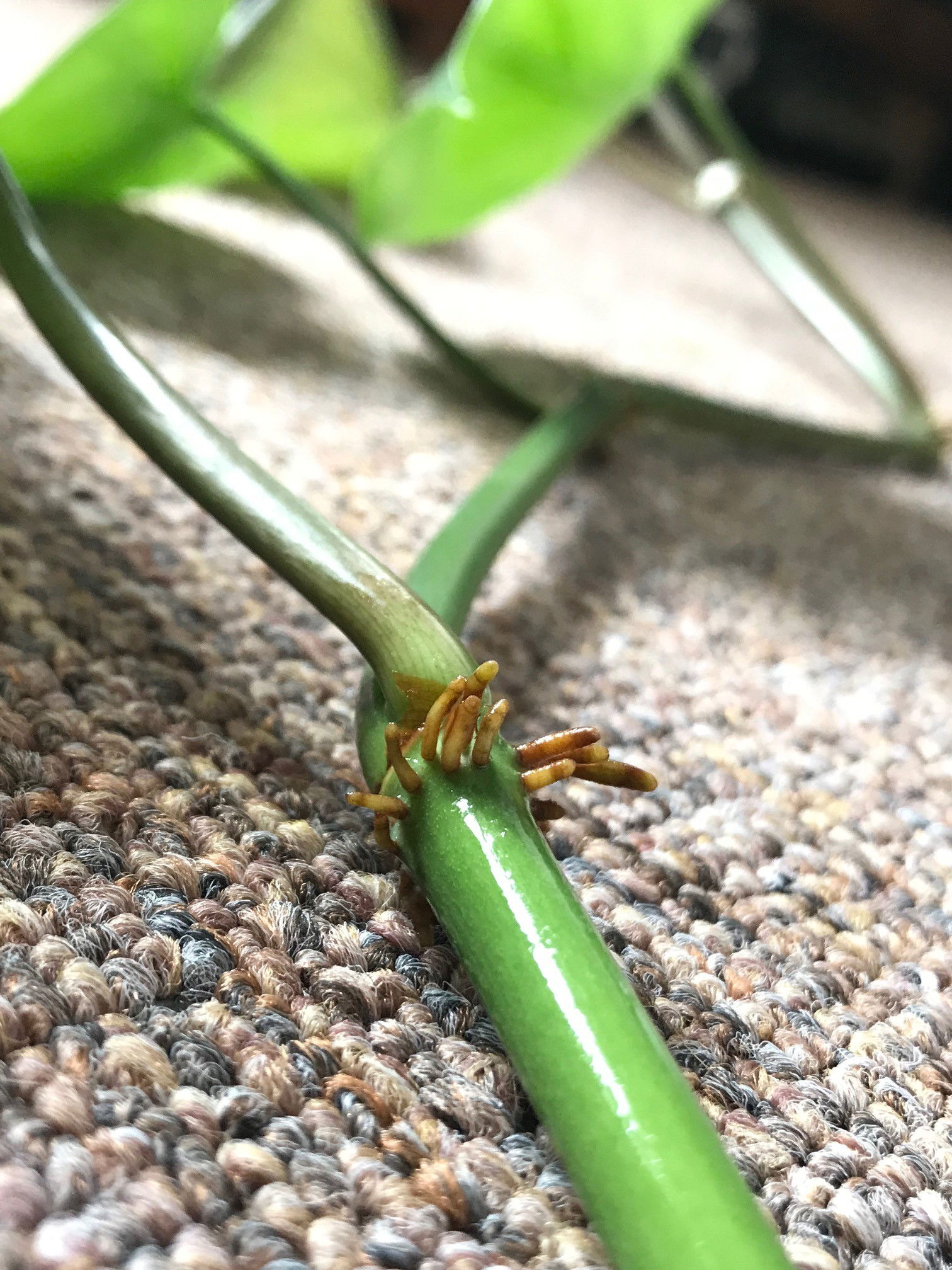 Nodes - Adventitious roots that'll develop below the nodal junction, to anchor the plant to its host. This is where the cutting will root from.
Nodes - Adventitious roots that'll develop below the nodal junction, to anchor the plant to its host. This is where the cutting will root from.
Stem Cuttings via Water Propagation (Easy & Recommended for Beginners)
- Choose the healthiest, most established vines. This propagation method can be taken from spring to summer, using between two to five leaves, with the vine being at least 8cm (2.5 inches) in length with two nodes (one for foliar development and the other for root growth). Although more nodes are fine, be sure only to submerge the bottom ones in water to avoid unneeded rooting elsewhere on the stem. (More on this later)
- Cut directly below a node using a clean knife to reduce bacteria count. Remove the lower half of the leaves and place the vines into a container of lukewarm water. Be sure to submerge at least one node into the water, or else the root development will be hindered.
- The leaves must stay above the waterline for the prevention of disease.
- Replace the water weekly, using lukewarm water to avert shocking the cutting with cold temperatures.
- Once the roots surpass 4cm (2 inches) in length, it's time to pot the cutting.
- Choose a potting mix - as long as it has a well-draining nature, most soils are fine. Either 'Houseplant' labelled compost or our Pothos & Hoya Soil Mix is suitable for potting up.
- Use a 7cm (2 inch) plastic or coir pot that has suitable drainage holes. Try not to transplant the cuttings too deeply in the soil as rot may occur.
- Fill the bottom quarter of the pot with soil, before sitting the cutting on top. Fill the remaining gaps with compost until the soil line reaches four-fifths of the pot's height. Lightly tap the pot's side to consolidate the soil into place. (Don't press down on the soil!)
- Provide bright, indirect light in a windowsill or under a grow light, along good humidity by placing the potted plant into a transparent plastic bag for the first couple of weeks.
- Open the bag every two days for an hour for the prevention of disease. After a month of being placed in soil, remove it from the bag and follow the care tips provided above.
 'Blackleg' can occur when a water-propagated cutting becomes diseased due to unsanitary conditions. We would recommend replacing the water twice weekly and to prune via the red line to discard the cutting's affected area.
'Blackleg' can occur when a water-propagated cutting becomes diseased due to unsanitary conditions. We would recommend replacing the water twice weekly and to prune via the red line to discard the cutting's affected area.
Stem Cuttings via Soil Propagation (Moderate)
This second option is still easy to perform, but it'll need some extra steps to avoid dehydration while the cutting roots in the soil.
- Choose the healthiest, most established vines. This propagation method can be taken from spring to summer, using between two to five leaves, with the vine being at least 8cm (2.5 inches) in length with two nodes (one for foliar development and the other for root growth). Although more nodes are fine, be sure only to submerge the bottom ones in water to avoid unneeded rooting elsewhere on the stem. (More on this later)
- Cut directly below a node using a clean knife to reduce bacteria count. Remove the lower half of the leaves and place the vines into a container of lukewarm water. Be sure to submerge at least one node into the soil, or else the root development will be hindered.
- Choose a potting mix - as long as it has a well-draining nature, most soils are fine. Either 'Houseplant' labelled compost or our Pothos & Hoya Soil Mix is suitable for potting up.
- Use a 7cm (2 inch) plastic or coir pot that has suitable drainage holes. Try not to transplant the cuttings too deeply in the soil as rot may occur.
- Fill the bottom quarter of the pot with soil, before sitting the cutting on top.
- Fill the remaining gaps with compost until the soil line reaches four-fifths of the pot's height. Lightly tap the pot's side to consolidate the soil into place. The leaves must always stay above the soil-line for the prevention of disease.
- Provide bright, indirect light in a windowsill or under a grow light, along good humidity by placing the potted plant into a transparent plastic bag for the first couple of weeks. Humidity will be your cutting's best friend, so ensure the plant doesn't dehydrate because of dry air.
- Open the bag every two days for an hour for the prevention of disease. After a month of being placed in soil, remove it from the bag and follow the care tips provided above.
Flowers
It's evidently rare for a Devil's Ivy to flower; the last known flower to bloom in the wild was in 1962. For those that are interested, Devil's Ivy form part of the Araceæ family that typically has a spadix surrounded by a spoon-shaped spathe. The best example of this would be a Peace Lily.
Repotting
Repot every three years in the spring, using a 'Houseplant' labelled compost and the next sized pot with adequate drainage. Hydrate the plant 24hrs before tinkering with the roots to prevent the risk of transplant shock. For those that are situated in a darker location, add a thin layer of small grit in the pot's base to improve drainage and downplay over-watering. Click here for a detailed step-by-step guide on transplantation, or via this link to learn about repotting with root rot.
If you're thinking of repotting a specimen that's growing up a moss pole, never remove the attached aerial roots as the disturbance could put further stress on the plant. Extend by purchasing another same-sized pole and pushing directly into the hollow hole in the original's top - its moss-like material may have to be cut off from the top to access the hollow centre. Get a long, sturdy stick that has a similar length to the two poles combined and place in the two's centre to support the weight. Always perform the repot BEFORE adding another pole, as it'll prove more challenging due to the weight distribution and overall balance. NEVER remove soil from the roots, or over-touch the root system, as this will cause transplant shock and possible death.
Book a 1-to-1 video call with THE HOUSEPLANT DOCTOR™ if you'd like a personal guide to repotting or training your houseplant onto a wall/moss pole. This will include recommending the right branded-compost and pot size, followed by a live video call whilst you transplant the specimen for step-by-step guidance and answer any further questions!
Pests & Diseases
Keep an eye out for mealybugs, spider mites, scale & thrips that'll locate themselves in the cubbyholes and undersides of the leaves. Typical diseases associated with Devil's Ivy are leaf-spot disease, botrytis & root rot; click here for more information about how to identify and address any of these issues.
Toxicity
This plant is classified as poisonous due to varying concentrations of calcium oxalate crystals found around the plant's body. If parts of the plants are eaten, vomiting, nausea and a loss of appetite could occur. Consumption of large quantities must be dealt with quickly; acquire medical assistance for further information.
Retail Locations
Homebase, B&Q, IKEA, Dobbies, British Garden Centres, Blue Diamond, Online Stores. Small 'Mossing Pins' to hold new vines onto a moss pole can be bought from Oasis Floral.
Book a 1-to-1 Call with THE HOUSEPLANT DOCTOR™
If you need further advice with your houseplants, book an advice call with ukhouseplants' friendly and expert writer today! This can be done via a video or audio call on most apps, including Facebook, FaceTime & Skype. A ten-minute call costs £5.99 (US$7), or £15.99 for thirty minutes. You can ask multiple questions, including queries on plants, pests, terrariums, repotting advice and anything in between. Please consider supporting this service to keep ukhouseplants thriving!